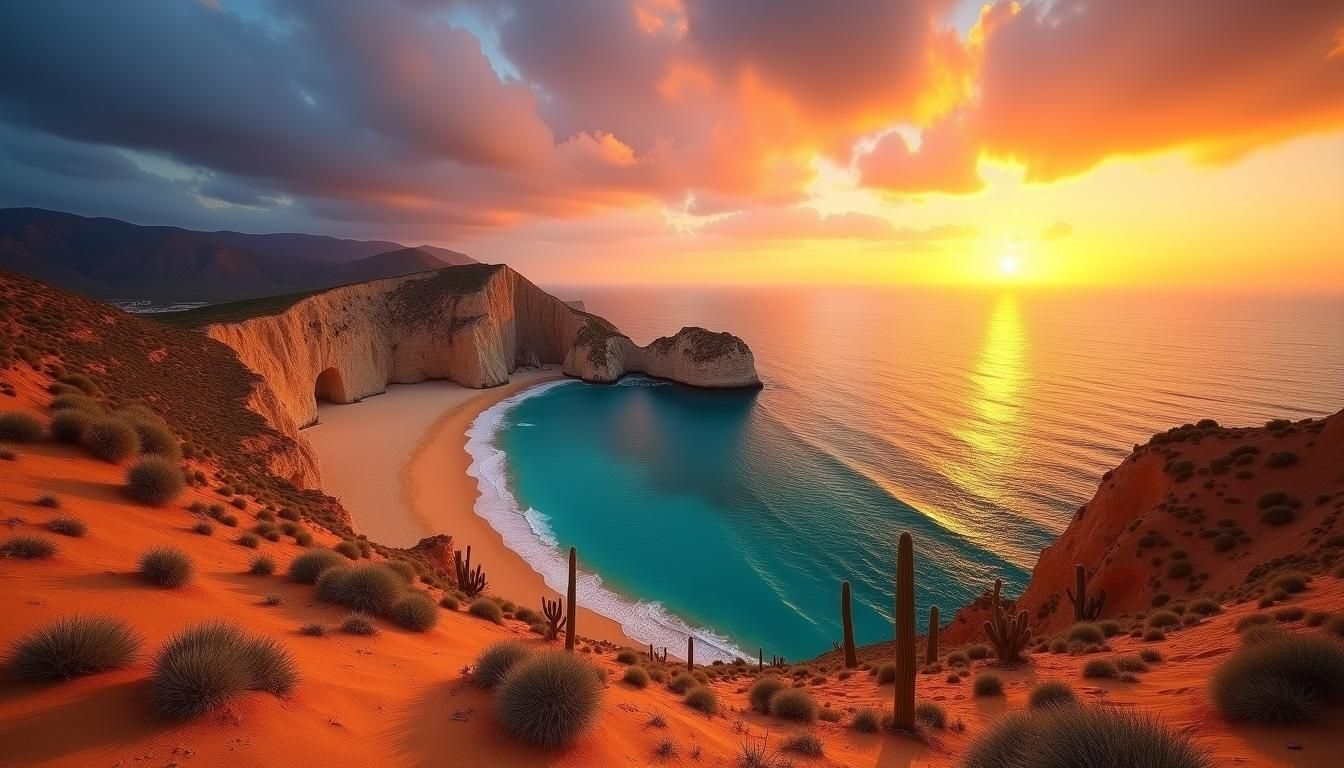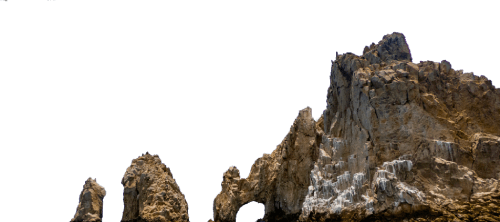
Cabo San Lucas, perched at the southern tip of Mexico’s Baja California Peninsula, is a place where extremes collide in spectacular harmony. Here, the arid desert stretches its golden fingers toward the turquoise embrace of the Sea of Cortez and the Pacific Ocean, creating a landscape so visually striking and ecologically rich that it feels like a work of art sculpted by nature itself. At Mucho Cabo, we’re captivated by this duality—a destination where cacti cast shadows on tide pools and desert foxes share the horizon with breaching whales. Let’s explore what makes this meeting of desert and sea so extraordinary.
Cabo’s dramatic scenery is rooted in a turbulent geological history. Approximately 12 million years ago, tectonic forces began pulling the Baja California Peninsula away from mainland Mexico, creating the Gulf of California (Sea of Cortez) in a process that continues today. This rift zone, where the Pacific and North American plates grind past each other, birthed the rugged Sierra de la Laguna and Sierra de San Lázaro mountain ranges. These volcanic peaks, rising between 400 and 1,000 meters, form a rain-shadow desert where dry air settles, sculpting Cabo’s iconic arid landscapes.
The region’s most famous landmark, El Arco (The Arch), epitomizes this geological drama. Carved by wind and waves at Land’s End, this granite arch marks the collision point of the Pacific Ocean and the Sea of Cortez. Nearby, the submarine sand falls of San Lucas Bay—a hidden wonder discovered by Jacques Cousteau—reveal sands cascading into a 1,200-foot-deep underwater canyon, a reminder of the dynamic forces still shaping Cabo’s seascape.
Cabo’s desert is far from barren. It’s a living tapestry of hardy flora and fauna adapted to thrive under the Baja sun. Towering cardón cacti dominate the landscape, some reaching 60 feet tall and living for centuries. These giants provide shelter for creatures like the coyote, desert fox, and Xantus’s hummingbird, an endemic species darting among agave plants and damiana shrubs. The latter’s leaves, brewed into traditional medicinal teas, hint at the desert’s hidden bounty.
Reptiles thrive here too: iguanas bask on sun-warmed rocks, while rattlesnakes and geckos navigate the scrub. Birdwatchers can spot roadrunners sprinting through the brush or the California quail’s distinctive plume bobbing among thorny thickets. This ecosystem’s fragility underscores the importance of conservation, as urban development and climate change threaten its delicate balance.
Just steps from the desert’s edge lies the Sea of Cortez, dubbed the “Aquarium of the World” by Jacques Cousteau. This marine paradise teems with life: over 20 species of whales and dolphins, including humpbacks and orcas, migrate through its waters. Between January and April, gray whales breach near shorelines, their calves in tow—a spectacle that draws visitors worldwide.
Beneath the surface, vibrant coral reefs host parrotfish, angelfish, and sea lions, while whale sharks—gentle giants weighing up to 20 tons—glide through nutrient-rich currents. Five species of endangered sea turtles, including leatherbacks and olive ridleys, return annually to nest on Cabo’s beaches. The intersection of desert and sea also creates unique tidal zones where hermit crabs scuttle between cactus shadows and tide pools brimming with anemones and starfish.
One of Cabo’s ecological crown jewels is the San José del Cabo Estuary, a lush oasis where freshwater from the Sierra de la Laguna mountains merges with the Gulf of California. This 125-acre wetland shelters over 200 bird species, including the endangered Belding’s Yellowthroat and the Least Bell’s Vireo. Crocodiles lurk in its marshes, while migratory birds like ospreys and herons pause here on their transcontinental journeys.
Despite pressures from tourism and development, the estuary remains a vital refuge, showcasing how desert and marine ecosystems can coexist. Conservation initiatives, such as habitat restoration and guided eco-tours, aim to protect this biodiversity hotspot for future generations.
Cabo’s landscape isn’t just a backdrop—it’s an invitation to explore. Here’s how to immerse yourself in its desert-meets-sea magic:
Cabo’s beauty is inseparable from its ecological fragility. As climate change and development pressure mount, sustainable tourism practices—like choosing eco-certified tours and respecting wildlife guidelines—are essential to protect this irreplaceable landscape.
At Mucho Cabo, we’re endlessly inspired by this region’s ability to merge extremes into something profoundly beautiful. Whether you’re watching a desert sunset paint the sea in gold or diving into waters where cacti cast reflections, Cabo reminds us that nature’s contrasts are its greatest masterpiece. Come explore with us, and discover a destination where every grain of sand and ripple of waves tells a story millions of years in the making.
